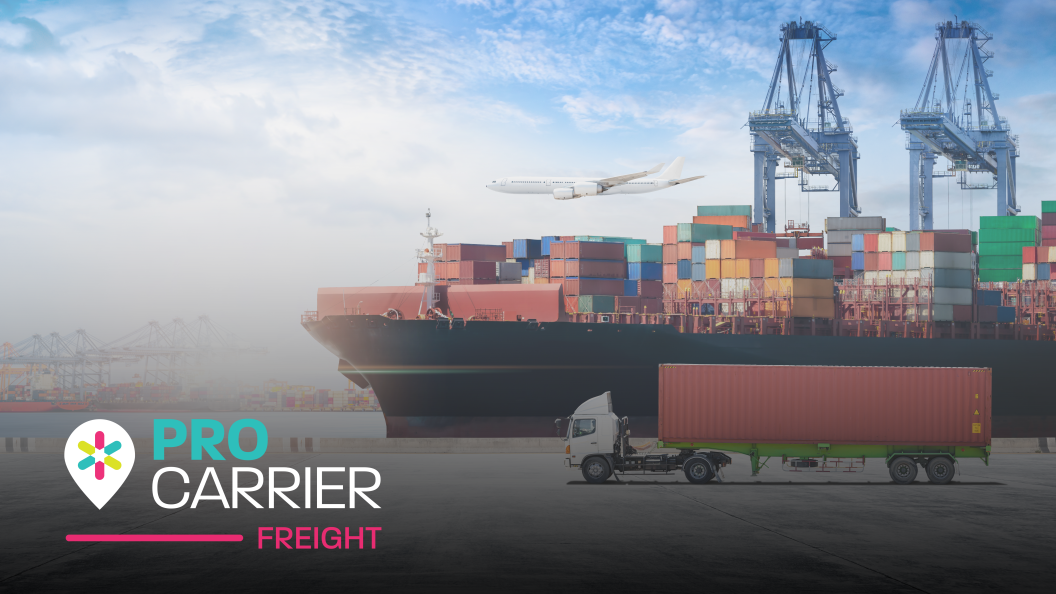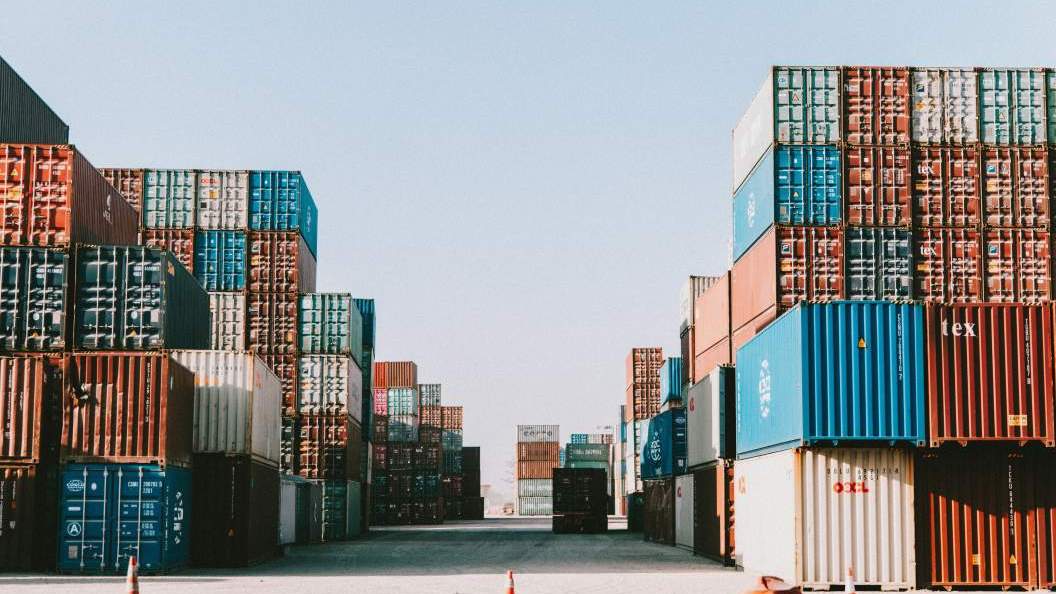Table of contents
- What is Road Freight?
- Key Road Freight Statistics
- Types of Road Freight Vehicles
- What are FTL, LTL, PTL?
- Comparing Modes Of Transport
- How Does Rail freight Compete?
- Intermodal vs Multimodal
- The Road Freight Market Opportunities and Challenges in 2023
- What Does the Future Look Like for Road Freight?
- Conclusion
What is Road Freight?
In short, road freight is when cargo is transported from one place to a specified destination via road networks. Technically this could even mean using your car to deliver any goods, however this article will focus on the road transport of goods via logistics companies and freight forwarders, giving you a comprehensive guide to the state of commercial road freight in 2023.
Key Road Freight Statistics
CO2 emissions as a result of road freight transport have been continuing to decline:
- In 2018 CO2 emissions were at 12350.30 thousand metric tons with 161,057.33 million tonne-kilometres freight transported*
- In 2019 this had decreased to 12110.30 thousand metric tons, but an increase of 163,697.74 million tonne-kilometres freight transported*
- 2020 continued this trend at 11547.30 thousand metric tons and 144,209.21 million tonne-kilometres freight transported*, possibly aided by the pandemic
- The Year-on-Year change of the Domestic European road freight market in 2019-2021 was at 1.7%, while the International market stood at 3.1%, due to the COVID Pandemic**
*Data collected from Statista – Freight and Cargo in the United Kingdom Dossier
** Data from Statista
Types of Road Freight Vehicles
There are different types of road freight vehicles for delivering goods and products.
Which type is chosen is dependent on several factors including the length of the journey to the size and nature of the cargo.
One of the biggest factors in the type of road freight being chosen for the journey can be the regulations enforced in the destination countries or areas, an example being the EU road freight regulations which currently apply to any vehicle with an empty weight of 3.5 t or more. The EU also restricts trucks to a maximum length of 18.25m, however certain countries allow longer Heavier Vehicles, or LHVs, that have lengths of over 25m. More information on the updated 2022 EU Road Freight Regulations can be found here.
What are FTL, LTL, PTL?
Much like sea freight uses incoterms such as LCL and FCL to determine the volume of shipments, road freight uses three incoterms to distinguish types of cargo: FTL, LTL, and PTL.
FTL (Full Truckload) - This means that the shipment requires booking the whole truck. This is useful for transporting any fragile goods that can’t be loaded with any other cargo, and is also quicker and often a good choice if you want to avoid other stopovers from other shipment bookings.
LTL (Less Than Truckload) - This means that only part of the truck’s volume is taken up by your shipment. Other consignees will also have their cargo on the same truck which makes LTL the slowest option due to multiple loadings and unloading.
PTL (Partial Truckload) - This is not too dissimilar to LTL, however the total amount of cargo will typically stay on the same truck from the departure point to the point of arrival.
See our article on the top four modes of transport for a detailed comparison.
Comparing Modes Of Transport

How Does Rail freight Compete?
When it comes to intercontinental freight shipping, the industry leaders of transatlantic and transpacific cargo will continue to be sea and air freight. This is simply due to the nature of the trade. However, Europe and Asia both have the ability to trade across borders via land.
This leaves land based cargo shipping to road freight, and the alternative option, Rail Freight. Both are viable options, with advantages and drawbacks of their own:
- Road freight is usually the quicker option as trains will more often than not, require multiple stops in order to unload and load on new cargo
- Longer distances may be better suited for rail freight as it can be quicker and is more economical than driving for journeys over 1000km
- Road would be better suited for shorter journeys
- Rail is more costly, however, is able to hold a greater amount of cargo in one journey
Advantages Road Freight:
- Ease of access, existing infrastructure, can get anywhere by roads
- Benefits other modes of transport as road will always be part of the journey even if from port to warehouse
- Doesn’t depend on ports airports etc
- Cheaper transport machinery - good for small freight
- Flexibility within routes - can be changed last minute and adapted
- Shorter lead times for smaller journeys
Disadvantages of Road Freight:
- Emissions
- Capacity is limited
- Affected by tolls
- Can be affected by traffic/ road network - height restrictions etc
- Dependent on the country’s road and traffic regulations
- Risk of goods being damaged or stolen
Intermodal vs Multimodal
Any shipper or freight forwarder will know that road freight plays a crucial role in multimodialsm.
Both of these shipping options have different factors that may be useful for your requirements, but they both entail utilizing multiple modes of transport when shipping from origin to destination. In this regard, road freight is extremely useful and more often than not, a necessary component for multimodal and intermodal shipping.
Read about the key differences between multimodal vs intermodal.
At Pro Carrier, we can provide data-driven, bespoke multimodal and intermodal shipping solutions that add value to your supply chain.
The Road Freight Market Opportunities and Challenges in 2023
The Road freight market continues to grow year on year, generating £32.07 billion in the UK 2021, and expected to reach £33.97 billion in the UK 2022 according to Statista. The European market is forecast to generate 417.02 billion euros by 2025. Despite the COVID pandemic in 2020, the market is at a steady incline, however, the capacity to satisfy market trends is declining. The effect of the pandemic and Brexit has meant that by February 2022, driver shortages have reached 70,000.
Prior to the pandemic and Brexit, the shortage had reach 60,000 drivers, showing that there were already issues in the industry, the major factor being driver retention. Due to factors such as low wages, less than ideal working hours and conditions, and training costs, most drivers left the industry completely before turning 45 years old.
Companies and the Government have been implementing updated regulations in order to combat this decline in drivers in both the short term and the long term. If you would like to know about the Government’s plans to tackle driver shortages you can read the article here.
What Does the Future Look Like for Road Freight?
When you think of electric, self-driving vehicles, the first name to come to mind is Tesla, and for good reason. The industry standard and leaders in EV manufacturing and market value have paved the way for other manufacturers to follow. This feed into the future of road freight, with the quest to lower emissions very much at the forefront of society, alternative forms of fuel are highly desirable. Hydrogen power, synthetic fuels and of course electricity are being made more apparent and plans are being drawn up to remove pollutants in many countries and governments. The sale of new petrol and diesel vehicles is intended to end by 2030 in the UK.
Of course with the idea of electric cars comes the digitization and automation of driving, rendering the human element of the industry obsolete. This may be one solution to tackle the shortage of drivers and meet the growing market standards and volume of freight.
Longer Heavier Vehicles (LHVs) may be a more attainable solution for the near future, having been seen to provide a more economical solution. Currently only permitted on select roads in Germany, these eight axle vehicles provide a greater capacity for freight, reaching lengths of over 25 meters. Not only do they provide more space, but they have been seen to reduce CO2 emissions as well as traffic conditions.
The ability to transport a larger amount of cargo, automatically eliminates the need for multiple trucks or multiple trips to complete the shipment journey, ergo reducing emissions and the need for multiple vehicles means less traffic on the roads. The lead times on delivering goods is shorter as a result and employee costs are actually reduced, as LHVs require less fuel per tonne.
Conclusion
Overall, road freight plays a key role in the logistics industry, and is heavily relied on as one of the shipping options for freight forwarders, especially when it comes to multimodal shipping, certain cross-border. The flexibility of choosing LTL, PTL, and FTL options means that you can rely on road freight no matter the size or volume of your goods.
Rail freight is considered a viable alternative to road due to its speed on shorter journeys, and being more economical. However, the ability to utilize the nation’s road networks and the many different types of road freight makes it one of the most efficient shipping options.
With emissions and the growing worldwide market demands, road freight is an extremely reliable method of transportation. However, as to what the future of road freight could look like, there are multiple possibilities. LHVs may be a quicker short term fix, but we could see full automation, electric trucking options, or even combinations such as automated LHVs within the next 15 years.
If you have any queries, or require any road freight services from a reputable freight forwarder, do not hesitate to contact us.



